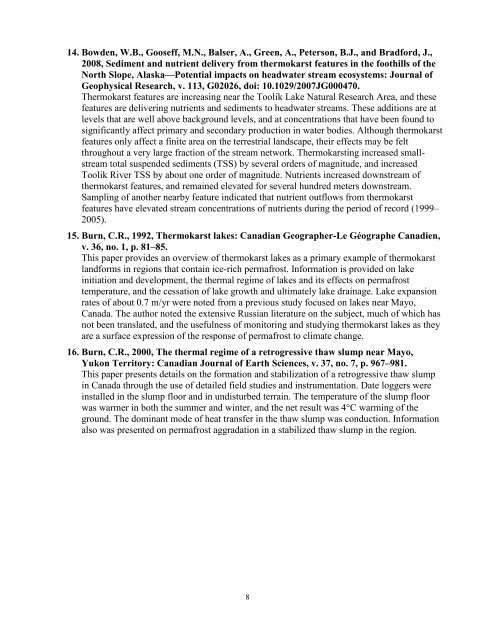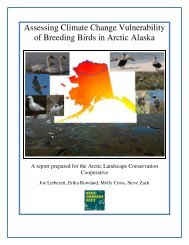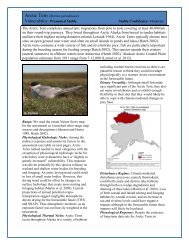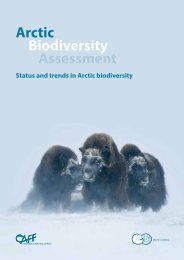Permafrost Terrain Stability and Thermokarst Monitoring: - Arctic LCC
Permafrost Terrain Stability and Thermokarst Monitoring: - Arctic LCC
Permafrost Terrain Stability and Thermokarst Monitoring: - Arctic LCC
You also want an ePaper? Increase the reach of your titles
YUMPU automatically turns print PDFs into web optimized ePapers that Google loves.
14. Bowden, W.B., Gooseff, M.N., Balser, A., Green, A., Peterson, B.J., <strong>and</strong> Bradford, J.,<br />
2008, Sediment <strong>and</strong> nutrient delivery from thermokarst features in the foothills of the<br />
North Slope, Alaska—Potential impacts on headwater stream ecosystems: Journal of<br />
Geophysical Research, v. 113, G02026, doi: 10.1029/2007JG000470.<br />
<strong>Thermokarst</strong> features are increasing near the Toolik Lake Natural Research Area, <strong>and</strong> these<br />
features are delivering nutrients <strong>and</strong> sediments to headwater streams. These additions are at<br />
levels that are well above background levels, <strong>and</strong> at concentrations that have been found to<br />
significantly affect primary <strong>and</strong> secondary production in water bodies. Although thermokarst<br />
features only affect a finite area on the terrestrial l<strong>and</strong>scape, their effects may be felt<br />
throughout a very large fraction of the stream network. <strong>Thermokarst</strong>ing increased smallstream<br />
total suspended sediments (TSS) by several orders of magnitude, <strong>and</strong> increased<br />
Toolik River TSS by about one order of magnitude. Nutrients increased downstream of<br />
thermokarst features, <strong>and</strong> remained elevated for several hundred meters downstream.<br />
Sampling of another nearby feature indicated that nutrient outflows from thermokarst<br />
features have elevated stream concentrations of nutrients during the period of record (1999–<br />
2005).<br />
15. Burn, C.R., 1992, <strong>Thermokarst</strong> lakes: Canadian Geographer-Le Géographe Canadien,<br />
v. 36, no. 1, p. 81–85.<br />
This paper provides an overview of thermokarst lakes as a primary example of thermokarst<br />
l<strong>and</strong>forms in regions that contain ice-rich permafrost. Information is provided on lake<br />
initiation <strong>and</strong> development, the thermal regime of lakes <strong>and</strong> its effects on permafrost<br />
temperature, <strong>and</strong> the cessation of lake growth <strong>and</strong> ultimately lake drainage. Lake expansion<br />
rates of about 0.7 m/yr were noted from a previous study focused on lakes near Mayo,<br />
Canada. The author noted the extensive Russian literature on the subject, much of which has<br />
not been translated, <strong>and</strong> the usefulness of monitoring <strong>and</strong> studying thermokarst lakes as they<br />
are a surface expression of the response of permafrost to climate change.<br />
16. Burn, C.R., 2000, The thermal regime of a retrogressive thaw slump near Mayo,<br />
Yukon Territory: Canadian Journal of Earth Sciences, v. 37, no. 7, p. 967–981.<br />
This paper presents details on the formation <strong>and</strong> stabilization of a retrogressive thaw slump<br />
in Canada through the use of detailed field studies <strong>and</strong> instrumentation. Date loggers were<br />
installed in the slump floor <strong>and</strong> in undisturbed terrain. The temperature of the slump floor<br />
was warmer in both the summer <strong>and</strong> winter, <strong>and</strong> the net result was 4°C warming of the<br />
ground. The dominant mode of heat transfer in the thaw slump was conduction. Information<br />
also was presented on permafrost aggradation in a stabilized thaw slump in the region.<br />
8








